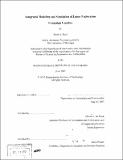| dc.contributor.advisor | Olivier L. de Weck. | en_US |
| dc.contributor.author | Shull, Sarah A. (Sarah Anderson) | en_US |
| dc.contributor.other | Massachusetts Institute of Technology. Dept. of Aeronautics and Astronautics. | en_US |
| dc.date.accessioned | 2007-12-07T16:11:13Z | |
| dc.date.available | 2007-12-07T16:11:13Z | |
| dc.date.copyright | 2007 | en_US |
| dc.date.issued | 2007 | en_US |
| dc.identifier.uri | http://hdl.handle.net/1721.1/39711 | |
| dc.description | Thesis (S.M.)--Massachusetts Institute of Technology, Dept. of Aeronautics and Astronautics, 2007. | en_US |
| dc.description | Includes bibliographical references (p. 138-140). | en_US |
| dc.description.abstract | As NASA prepares to establish a manned outpost on the lunar surface, it is essential to consider the logistics of both the construction and operation of this outpost. This thesis presents an interplanetary supply chain management and logistics planning and simulation software tool, SpaceNet, developed to assist mission architects, planners, systems engineers and logisticians in performing analysis on what will be needed to support future human exploration missions, primarily in the Earth-Moon-Mars system. Also presented in this thesis are the results of numerous trade studies performed using SpaceNet to determining the best mix of mission types (pre-positioning, carry-along and resupply) to achieve sustainable, robust space exploration. These trade studies focus on analyzing notional mission architectures in terms of scientific benefit, logistical overhead and robustness to campaign level risks such as flight delays, flight cancellations and uncertain demand parameters. The significant findings presented in this thesis broadly fall into three categories: a demonstration of the value of integrated modeling and simulation of campaign logistics, the best logistics strategy for the establishment of a lunar outpost, and suggestions to reduce campaign level risk. | en_US |
| dc.description.abstract | (cont.) The development of SpaceNet has made several key contributions to the field of space logistics, primarily in the creation of a set of ten function-based classes of supply for human space exploration, the detailed modeling of demand parameters at the supply class level, and the ability to model entire campaigns of missions and to compare these campaigns using the measures of effectiveness developed. Through the campaign analysis it is shown that the Lunar Architecture Team (LAT) Option 1 lunar mission architecture is ~11,500 kg short of being able to support four crew members for the proposed durations. It is also shown that the inclusion of at least two unmanned cargo missions makes the architecture sustainable. The campaign level risk analysis research performed demonstrates that the best way to protect against schedule and demand uncertainty is to maintain at least a 90-day safety stock of consumables at the lunar base (~2100 kg for a crew of four). | en_US |
| dc.description.statementofresponsibility | by Sarah A. Shull. | en_US |
| dc.format.extent | 140 p. | en_US |
| dc.language.iso | eng | en_US |
| dc.publisher | Massachusetts Institute of Technology | en_US |
| dc.rights | M.I.T. theses are protected by copyright. They may be viewed from this source for any purpose, but reproduction or distribution in any format is prohibited without written permission. See provided URL for inquiries about permission. | en_US |
| dc.rights.uri | http://dspace.mit.edu/handle/1721.1/7582 | |
| dc.subject | Aeronautics and Astronautics. | en_US |
| dc.title | Integrated modeling and simulation of lunar exploration campaign logistics | en_US |
| dc.type | Thesis | en_US |
| dc.description.degree | S.M. | en_US |
| dc.contributor.department | Massachusetts Institute of Technology. Department of Aeronautics and Astronautics | |
| dc.identifier.oclc | 176895460 | en_US |
